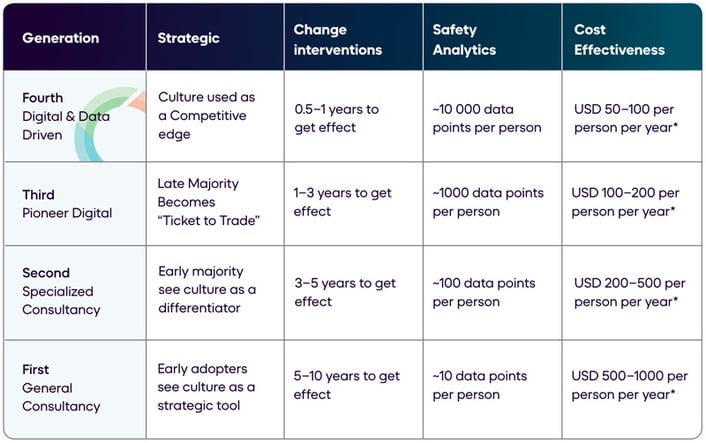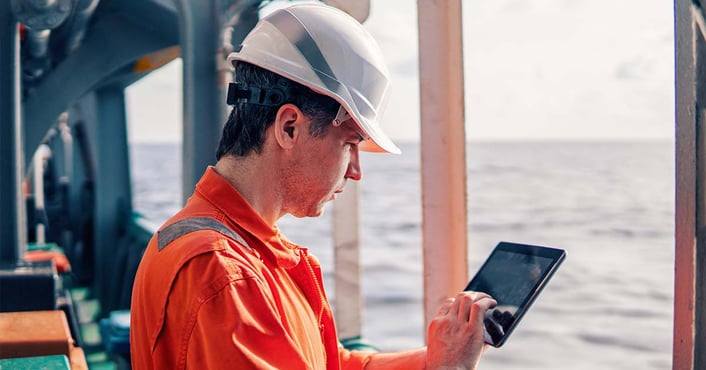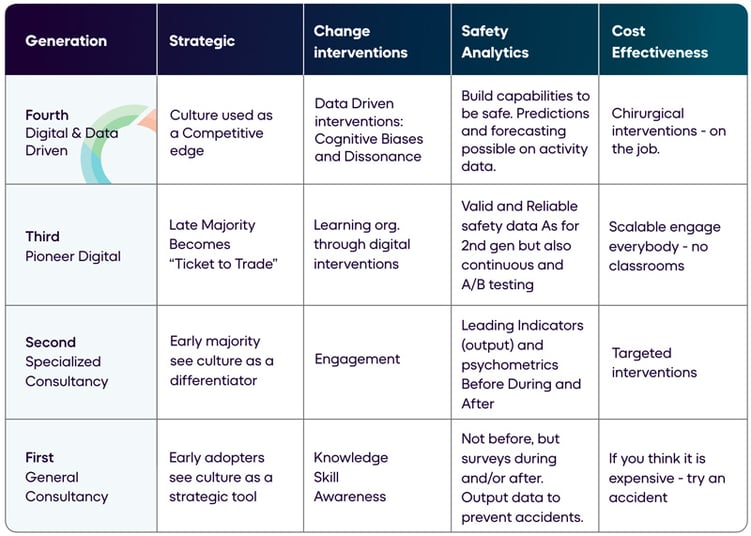Cultural change has always existed but has developed significantly in recent years. This article describes four generations of culture change processes and pinpoints the value propositions of each generation.
While the content of cultural change naturally varies significantly across organizations, nations, and religions, the very process of achieving cultural changes has made significant progress over the last few decades. A generational shift occurs when the value propositions of a new process outperform the existing culture change process.
The value propositions of culture change processes pursue four main drives; Strategic, Change Interventions, Safety Analytics, and Cost-Effectiveness. Early adopters saw the first generation of change processes and realized that it was possible to use culture as a tool to implement strategic changes.
Because of the increased attention to a mature organizational culture, the strategic importance has improved for each new generation and is now considered “a ticket to trade” and used as a competitive edge. Also, the Change Interventions have shifted from the general approach addressing “Knowledge, Skills, and Awareness” to targeted data-driven cognitive biases and dissonance in the fourth generation.
 * for companies of 1500-4000 employees
* for companies of 1500-4000 employees
Generation One – The Pioneers of Safety Culture
In the mid-1980s, the Swedish shipping company Stena engaged the whole workforce onboard and ashore in seminars and meetings to create the company culture they all wanted. The focus was on the business but involved everybody to facilitate the needed changes. The approach proved to be effective not only for business. There was also a noticeable drop in the frequency of ship accidents that lasted for a decade.
When the late Ingar Skaug was hired as CEO at Wilhelmsen Lines in 1990, he started an extensive change process focusing on company values, empowerment, and engagement. Even though everybody was engaged in the change initiative, the key was strengthening the leadership functions to more empowered and thorough decision-making. In this perspective, the change initiative seemed more top-down than bottom-up (even though bottom-up was also taking place in seminars and surveys).
Another well-known change initiative was the oil major Equinor’s “Kollega Program,” which kicked off in 2003. The program was a bottom-up based gram where 17.000 employees and contractors were invited to seminars with motivational speakers, workshops, and messages from key personnel. The program’s total costs in terms of travel, accommodation, content, and lost work time must have totaled several USD 10s of millions.
The significant change initiatives in Stena, Wilhelmsen, and Equinor, as many other change initiatives at the time, were kicked off based on the gut feel assessment of executives and consultants. The measures are what we refer to as first-generation change initiatives. The effect of the programs was evaluated in a survey assessment after or during the interventions. Even though there were no benchmarks before the intervention started, the results seemed significant. These pioneers formed several value propositions for developing organizational culture:
- Strategic: See culture as a strategic tool
- Change Interventions: Design based on gut feel
- Safety Analytics: If analytics is used, it is during and after
- Cost-Effectiveness: Given relative to not doing anything or experiencing an accident

Generation Two – Empowering the Workforce
A new generation of culture change processes became apparent at the beginning of the millennium. With additional assessment tools to understand culture through psychometric surveys, in-depth interviews, and observations, it became possible to understand the current organizational culture better and use the insights to measure improvement. However, the understanding of the effect of various interventions was still immature.
In the early 2000s, several studies were published where the same organizational culture survey was used on several companies to evaluate differences and similarities. The approach was controversial at the time, as many schools of professions saw corporate culture as a unique feature of any organization that could neither be measured nor compared with others.
This skepticism has slowly lost support as reliable and validated surveys have been developed. These surveys were used as before and after measurements to identify specific improvement areas in different places of an organization. The use of such surveys is what is typical for the second generation of change programs.
In 2004 SAYFR personnel did the first program for a large chemical tanker company based on the results of a company-wide survey. The interventions included workshops with operational leaders, communication, and promotion material. The results were fair but time-consuming.
The second generation of culture change provided a significant understanding of what “great looks like” and “how to make effective changes.” The evolution led to increased attention to the importance of involvement and engagement. Simultaneously “gamification” became a buzzword, and parents worried about their children being too engaged and even immersed in digital worlds. As everybody has a smartphone, reaching everybody on a new device is possible. The summary of the value proposition for the second generation of the culture change process on top of the first generation:
- Strategic: Prove that a culture is a strategic tool.
- Change Interventions: Engaging the workforce by involving them.
- Safety Analytics: Use surveys and psychometrics
- Cost-Effectiveness: Targeted interventions based on expert judgment significantly improve the return on investment.
Generation Three – Technology is Catching Up
The combination of cultural understanding, culture change, and engagement through gamification formed a third generation of cultural change. A significant drawback of the second generation of cultural change is the need for more scalability. Applying new digital technologies allows for a far more scalable change process where you can reach everybody on their smartphone.
The third generation of interventions two-folded. There is one top-down implementation and a bottom-up implementation with different interventions. In broad terms:
- Top-down interventions:
- I1: Leadership onboarding and training
- I2: Facilitation of safety meetings to agree on safety improvements.
- Bottom-up intervention:
- I3: 3D training modules on personal devices for all employees
The first intervention (I1) intends to prepare key leaders to drive the culture change process. One approach is to start over video call sessions carried through over time. The first vice-call is to explain the purpose of the program and the importance of their role in the program. Top management representatives participate in the introduction and then leave this session. Then actors play out situations where Trust and Care make a difference in how leaders interact with colleagues. After this session, all participants complete a type-test before meeting a certified coach in the second video call. The coach helps all the leaders to identify strengths and weaknesses they should be aware of during the implementation. The third and last video call is to make the final practical preparations for the leaders.
But more than engaging the personnel is required. The engagement must be manifested in actual on-the-job changes. You can do this in seminars or meetings where the departments or teams agree on where they can contribute to improvements. Engaging your personnel is, in fact, the purpose of the second intervention (I2).
To facilitate this improvement process, the participants of the I1 get access to digital tools to assist them in facilitating these meetings. The topics of the discussions are linked to the Intervention 3 training modules. The meetings are held periodically, ranging from bi-weekly to every second month. The panels’ output is functional changes to work on until the next team meeting.
The third Intervention (I3) is the gamified simulations made available on an app on personal devices. This intervention aims to raise understanding and awareness of how interpersonal collaboration can prevent or escalate failures to critical situations. The gamified training modules are inspired by major accidents and the social interaction that led to these incidents. The value propositions of the third generation can be summed up as:
- Strategic: Late Majority Becomes “Ticket to Trade.”
- Change Interventions: Learning org. through digital interventions
- Safety Analytics: Valid and Reliable safety data
- Cost-Effectiveness: Scalable engage everybody - no classrooms

Generation Four – The Age of Big Data and Prediction
What distinguishes the fourth generation of interventions from the third is its origin. While the third generation was a digitalization of existing capabilities, the fourth generation interventions have been designed based on the digital experience of the third generation.
Herein lies a major shift within organizational culture and safety culture. Over the past, there has been a tendency where people have pulled the “safety card” for all sorts of suggestions without being able to prove the actual impact on safety. With a data-driven approach, this argumentation is turned upside down. The data suggests where the must-win battles are for safety.
There are many examples of how this comes into practice. For example, how does the training involve culture? Is it the test scores of how much people know? The data tells us that the test scores have low – and even a negative correlation with culture change. The time spent on the topic and how many times the issues are repeated drive the learning. And even more precisely, what can you expect of culture change if each person only spends half an hour instead of two?
This data-driven approach has pinpointed the Cognitive Biases of Safety, which were not identified in the earlier generations. It manifests the Value Proposition of the fourth-generation Culture Change Processes:
- Strategic: Culture used as a Competitive Edge
- Change Interventions: Data-Driven Interventions: Cognitive Biases and Cognitive Dissonance
- Safety Analytics: Build capabilities to be safe
- Cost-Effectiveness: Surgical interventions - on the job
Glancing Behind and Peeking Ahead
The Value Propositions for the Culture Change Processes have changed dramatically over the last few decades. The biggest strength of the first generation was the strategic Value Proposition. These pioneers demonstrated the possibility of building a more mature safety culture.
The most favorable Value Proposition of the second generation was on Safety Analytics. Surveys and psychometric tools were used to set a baseline for improvements, identify improvement areas and select appropriate interventions.
The largest step-up for the third generation was scalability, making it possible to reach all simultaneously with engaging digital content. This scalability reduced the costs per person beyond what was earlier imagined.
The strength of the fourth generation is data-driven interventions, where the Cognitive Biases of Safety are one of many examples.

So what will the fifth generation look like? We still need to find out. But it would not be surprising if it involves new opportunities within areas such as virtual reality, artificial intelligence, augmented reality, robotics, and sensors.
Have you seen our guide on the future of safety? Download it today!








